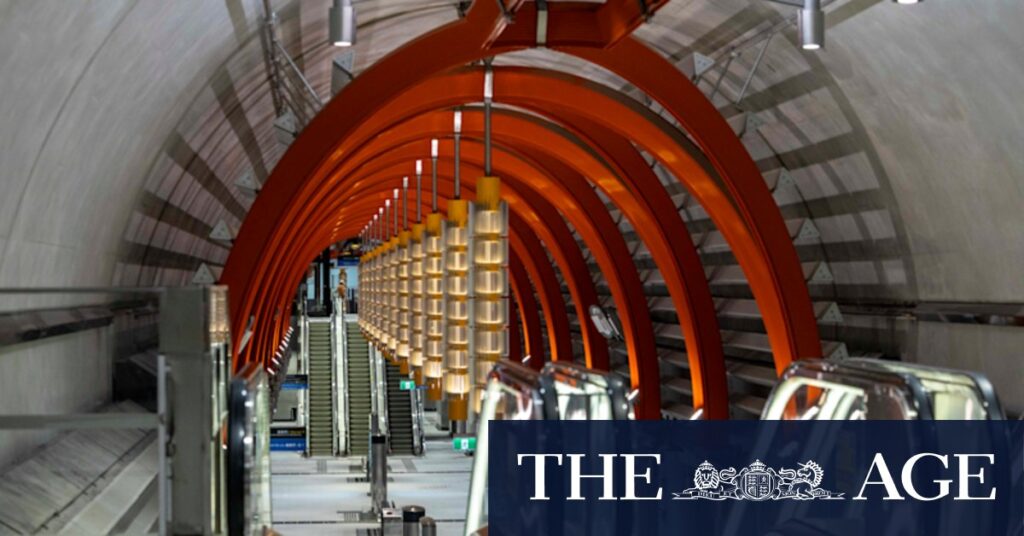
You hear it before you see it. And you feel it before you hear it. The dull tremor of mass moving at speed. The whumpfh of air pushed through a confined space. The whine of electric motors. And then, finally, the glow of headlights in the gloom. Construction on the first new Melbourne CBD train station in more than 40 years is finally finished: Town Hall Station, dug 27 meters below Swanston Street.
While it is not yet open to commuters, the station is already a hive of activity with ghost trains running during a testing phase of the five new Metro Tunnel stations. These ghost trains are not operating at full service, yet their frequency is striking. In some instances, barely 30 seconds pass between one train leaving and another arriving.
“This is literal turn up and go,” says Kate Walshe, director of communication for builders CYP Design and Construction, during a media tour of the station on Saturday. “Throw away the timetable.” The station’s designers are confident in the pace of the new service, to the extent that platform seating is minimal, reflecting their belief that it simply won’t be needed.
Innovative Design and Technology
Town Hall Station is one of five new stations along the new Metro Tunnel, set to open later this year, though the government remains tight-lipped on an exact date. The twin tunnels, carved beneath the city, create a direct connection between Melbourne’s growth corridors in the northeast and southwest, with the project costing taxpayers $13.4 billion, significantly above the initial $10.9 billion budget.
Designed to mirror the architecture of Town Hall, the station’s entrance features five long escalators descending into a concrete box, whimsically dubbed “the crypt” by architects. The space is open to the public, with plans for a coffee shop, retail spaces, and a large screen, making it a potential venue for public events.
The platforms themselves are a marvel of engineering. Boring machines have carved three side-by-side cylinders out of the bedrock, creating expansive platforms that are among the widest metro platforms in the world at 18 meters. The total space excavated is more than a city block long and a five-story building deep.
Technological Advancements
The station boasts two key pieces of technology. The first is high-capacity signaling, which wirelessly links trains, allowing them to automatically adjust speed and maintain safe distances, akin to radar cruise control in cars. This automatic control enables trains to run closer together, facilitating the faster service that has been demonstrated.
The second innovation is the platform screen doors, which completely enclose the platform when shut and open in concert with train doors. “You don’t have the gush of hot wind when it’s baking down here,” says Walshe. These doors are expected to enhance service reliability by preventing objects and people from falling onto the tracks, while also maintaining thermal stability without the need for heating or cooling.
Artistic and Functional Design
Navigation within the station is intuitive, featuring “shark fins” on the roof to guide passengers. One side is painted pink, symbolizing the direction towards the exit, while the other is grey, guiding towards the platform. The design draws inspiration from Melbourne’s sunrises and sunsets, utilizing a palette of white, pink, yellow, and orange. “The sunrise and sunset is timeless,” remarks Walshe.
While each station entrance is unique, the platforms themselves lack distinct personality, appearing almost identical from station to station. This uniformity requires passengers to remain vigilant to avoid disembarking at the wrong station. Unlike the themed and elaborately decorated Moscow Metro, Melbourne’s new stations prioritize functionality over ornate design.
Historical Context and Future Implications
The completion of Town Hall Station marks a significant milestone in Melbourne’s transportation history, being the first new CBD train station in over four decades. This development follows years of planning and construction, aimed at alleviating congestion and improving connectivity across the city.
As we conclude our tour at Campbell Arcade, the pink 1950s-era underground shopping strip now connects Town Hall and Flinders Street stations. Working with Heritage Victoria, builders have incorporated granite columns and small tiles, giving the new section a sense of age and continuity with the past.
As we exit the gates of Flinders Street Station, a young woman attempts to enter, only to be thwarted by a malfunctioning ticket validator. “I don’t know what happened, I literally topped this up yesterday,” she exclaims. “Myki sucks.” While Melbourne’s train system is poised for transformative change, some aspects remain persistently familiar.





